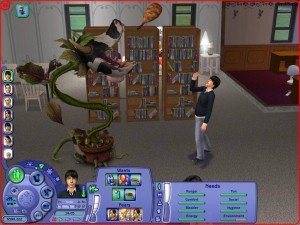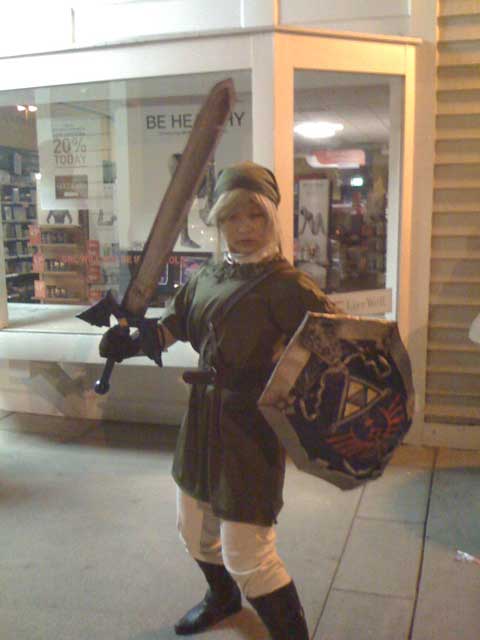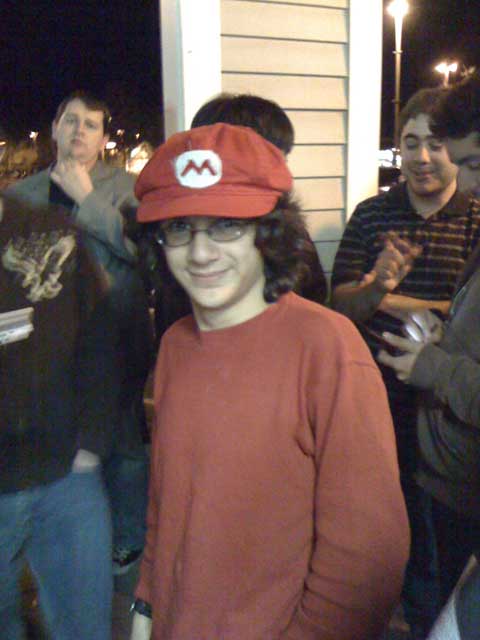Archive for the 'Games in Real-Life' Category
mario September 23rd, 2011
 Cheryl Platz (writer of the excellent blog twenty-sided woman which you should all be reading on a regular basis WHY DON’T YOU GET ON THAT) wrote a post today describing the antiquated state of iconography in user interfaces that got me into a UX sort of mindset. She describes how Windows is moving away from such abstracts, preferring more straightforward tiles containing text descriptions. But I started thinking about another source of iconographic inspiration that I think she and the rest of you might find interesting… Cheryl Platz (writer of the excellent blog twenty-sided woman which you should all be reading on a regular basis WHY DON’T YOU GET ON THAT) wrote a post today describing the antiquated state of iconography in user interfaces that got me into a UX sort of mindset. She describes how Windows is moving away from such abstracts, preferring more straightforward tiles containing text descriptions. But I started thinking about another source of iconographic inspiration that I think she and the rest of you might find interesting…
Even in the most modern of word processors and spreadsheet editors, most of the button interaction is represented by vague analog metaphors. The last time I interacted with a floppy disk, I was using them as coasters for a Hackers-themed movie night! (long story short, you missed out) And as Cheryl mentioned, clipboards aren’t an obvious analogy for applying duplicated information, so why did it become the standard for something as frequently evoked as “Paste”? Microsoft’s solution, as outlined in their previews for Windows 8’s Metro UI, is to replace those tiny icons with large, touchable rectangles detailing the contents of each application and service. Go ahead and watch the video:
https://youtu.be/p92QfWOw88I
Not too shabby! Metro looks very touch control-friendly and the icons clearly communicate their purpose. But I want to take another brief look at the tiny icons that have served us in the pre-post-PC world and think of another way to utilize them:
A video game-style tutorial mode.
Video games have been trying to deal with relating digital actions to real world analogs for at least as long as productivity applications. In fact, games have it a lot tougher: while you may perform tasks somewhat resembling saving and cut/copy/pasting in everyday life, you’re far less likely to find yourself, say, controlling the actions of a hapless family of avatars as they seek out lives and careers.
A game has to get the player familiar with a wholly alien interface in a very short period of time if it wants to keep said player engaged. As technology advances and games increase their capabilities, control schemes necessarily become more complex. Soon a large portion of the screen is devoted to complicated button layouts, and there isn’t always space for textual descriptions explaining the functions. Let’s look at this screenshot from The Sims 2 (click to enlarge):
 (The Sims makes for a good comparison since it, like a word processor with a toolbar, is a largely mouse-driven interface)
See that dial on the bottom-left corner? It’s loaded to the brim with icons attempting to communicate functionality with simple pictographs. And you know what? It’s not always succeeding. From my past experiences with other user interfaces and societal conventions, I can probably figure out a few of these buttons; the plus/minus and curved arrow look like they could be related to camera controls, the sun/leaf/snowflake/tulip pictures presumably correspond to the seasons. Random clicking will probably yield more information about the other controls.
But what if I’m not the type of game player that wants to take risks by random clicking? Or going back to the original point, what if I’ve just finished typing up my very first Microsoft Word document, and I don’t inherently know that a picture of thirty year-old data storage technology that most computers don’t even support anymore represents the action of saving my work? Am I expected to click wantonly until the desired result is obtained?
How, then, do video games overcome this problem? Since their inception, most games come with instruction manuals detailing how to perform all the actions you need to get started, but who in the Word or Sims scenarios really reads a manual? No, the real way for a game to instruct on these behaviors is with a guided, in-game tutorial. Almost every modern game has the ubiquitous “tutorial mode”, handholding the player as it painstakingly describes each essential button and refusing to proceed until we apply their instructions and repeat the stated actions. The game teaches you what a mouse click does, then patiently waits for you to click that mouse button.
What would users think if Microsoft Word 2012 came with a tutorial mode? Before you write your Great American Novel, out comes Clippy with a mandatory walkthrough describing the functions of all the most commonly-used buttons on the toolbar. Users would painstakingly be guided through the concepts of copying and pasting, of right-justification, of embedding hyperlinks. Every person that ever used Word would have this shared educational experience (unskippable, of course), giving all users a much-improved baseline of knowledge and self-sufficiency.
At this point, it wouldn’t matter what we put on the icons. The floppy disk becomes no more useful a graphical representation than a National Geographic photo of a panda chewing on bamboo. It would be a wonderful opportunity to immediately phase out all this outmoded imagery and replace it with more interesting and timeless abstractions. Since everyone did the tutorial, the panda button would be a self-evident representation of saving our work. Clippy said so in the walkthrough. By applying a button’s function within the context of the action, we effectively remove the abstractness from the abstraction.
It should be noted that this is actually a terrible idea. But if some up-and-coming developer implemented something like this in his indie word processor, I’d certainly give the tutorial level a go.
 [ discuss on the forum]
mario March 18th, 2009
 It’s been a long time since I used this blog for its original purpose of writing about video game things that tickle my fancy. I don’t have much to say on this front, except that I honestly haven’t been playing a lot of video games for some time now, and have had a correspondingly dwindling interest in game news sites. However, I’ve been trying to get back in the habit of reading said sites, and I was glad to see a splendid payoff in the form of a podcast recommendation! It’s been a long time since I used this blog for its original purpose of writing about video game things that tickle my fancy. I don’t have much to say on this front, except that I honestly haven’t been playing a lot of video games for some time now, and have had a correspondingly dwindling interest in game news sites. However, I’ve been trying to get back in the habit of reading said sites, and I was glad to see a splendid payoff in the form of a podcast recommendation!
The show, titled “A Life Well Wasted”, takes a page from the excellent radio show This American Life in its format: each hour they choose a theme and deliver a variety of stories on that theme, only in this case the themes focus more on the gaming community and culture. I’m currently listening to the first episode, focusing on Electronic Gaming Monthly’s demise. I strongly urge everyone to give the show a listen.
As far as I can tell, the host, Robert Ashley, does all the writing and production for the show on his own, which explains why he’ll be making about one episode per month. Hopefully he starts assembling a staff to ease the workload and help increase the rate of production, because this is a brilliant idea that we need to see more of! Hey Robert Ashley, you looking for any writers or production assistants? I’m game.
[discuss]
mario August 29th, 2008
 Figured I’d be a few hours late to the party instead of a few weeks (like normal): Stardock (developers of one of those OS X Dock hacks for Windows and probably other stuff) and Gas Powered Games (developers of the technology to end games’ names with “Siege”) have teamed up to pen a Gamer’s Bill of Rights. Edge Magazine ran a piece by Stardock CEO Brad Wardell, who lays out his mandates in a clear-cut manner and goes into a little detail on a few of the juicier declarations. The document is basically a laundry list of complaints both old and recent regarding the PC gaming environment (the consoles are largely devoid of these grievances). Though I try not to make a habit of reposting large chunks of others’ content, I feel having the entire body of work will help the discussion along (go check out the article as well, of course): Figured I’d be a few hours late to the party instead of a few weeks (like normal): Stardock (developers of one of those OS X Dock hacks for Windows and probably other stuff) and Gas Powered Games (developers of the technology to end games’ names with “Siege”) have teamed up to pen a Gamer’s Bill of Rights. Edge Magazine ran a piece by Stardock CEO Brad Wardell, who lays out his mandates in a clear-cut manner and goes into a little detail on a few of the juicier declarations. The document is basically a laundry list of complaints both old and recent regarding the PC gaming environment (the consoles are largely devoid of these grievances). Though I try not to make a habit of reposting large chunks of others’ content, I feel having the entire body of work will help the discussion along (go check out the article as well, of course):
The Gamer’s Bill of Rights
We the Gamers of the world, in order to ensure a more enjoyable experience, establish equality between players and publishers, and promote the general welfare of our industry hereby call for the following:
1. Gamers shall have the right to return games that don’t work with their computers for a full refund.
2. Gamers shall have the right to demand that games be released in a finished state.
3. Gamers shall have the right to expect meaningful updates after a game’s release.
4. Gamers shall have the right to demand that download managers and updaters not force themselves to run or be forced to load in order to play a game.
5. Gamers shall have the right to expect that the minimum requirements for a game will mean that the game will adequately play on that computer.
6. Gamers shall have the right to expect that games won’t install hidden drivers or other potentially harmful software without their express consent.
7. Gamers shall have the right to re-download the latest versions of the games they own at any time.
8. Gamers shall have the right to not be treated as potential criminals by developers or publishers.
9. Gamers shall have the right to demand that a single-player game not force them to be connected to the Internet every time they wish to play.
10. Gamers shall have the right that games which are installed to the hard drive shall not require a CD/DVD to remain in the drive to play.
Personally, I would have liked it if such an important document had been created by some sort of gamer legislature, instead of a missive from above (you know, a series of laws instead of a pair of stone tablets), but it’s hard to argue against any of the points made. The efforts on the part of game companies to curb piracy has resulted in an environment that hinders the average legal game owner’s ability to actually play the game they paid for. I love The Orange Box, but it feels awful weird having to connect to Steam whenever I need a quick offline Portal fix.
The saddest part about this whole document is that it had to be made in the first place. Most everything listed (except maybe having the physical media in the drive to play; it’s an effective anti-piracy measure that every owner of the game should be able to easily comply with, so quit yer whining) is common sense.
Of course, I do understand the needs to stop piracy, and a company blindly accepting these as policy without coming up with alternative means of protecting their assets is just asking for trouble, but it’d be nice if they gave some thought toward their customer’s… well, I wouldn’t exactly call them rights. More like ideals. In any case, I’ll readily support any company that supports such a bill (printing it on the box would be a nifty gesture). Speaking of which, this is apparently a picture of the document, possibly as seen at PAX?
.jpg)
(courtesy of GamePolitics)
[discuss]
mario March 9th, 2008
Brawl is out! Brawl is out! Brawl is out!
I went down to my local GameStop last night to try my luck at the tournament scene (got KO’d in sudden death first round), and to stand in line to pick up my copy of Super Smash Bros. Brawl at midnight. The crowd was hyped up and enthusiastic, and the tournament-goers were all good sports. I saw some wonderful homemade costumes so great that I had to snap a few photos:
 
I stayed up for hours playing the game last night, and did another huge marathon session today. This game is a marked improvement on the GameCube title in almost every way (no more sideways midair dodge? You’re killin’ me Smalls!), the online battles are absolutely wonderful, Subspace Emissary is the best single-player campaign they’ve ever offered (if you’ve ever played the Halberd level in Kirby Superstar, it’s kinda like that: long, epic, difficult, awesome; probably helps a lot that HAL Laboratories made both games)… I finally had to take a break to catch my breath. But you can be sure I’m up for taking on any challenger. Bring it, as they say.
[discuss]
mario January 12th, 2008
 A group of, let’s face it, insane Zelda fans at cameronbanga.com have decided to play straight through Ocarina of Time, Majora’s Mask, Wind Waker and Twilight Princess in the span of 48 hours! Go check out the live video feed! They’re also reading email during the event, so send them a message to show them your support, and let ’em know who sent you! They’re also accepting money donations, and whatever they don’t spend on food is going toward Penny Arcade’s Child’s Play charity; if you’ve got any money to spend, Child’s Play is a great cause (I’ve talked about it in years past, they donate toys and video games to children in hospitals), and this is an awesome way to support a fine charity. But we can all agree that these guys are still a little crazy. A group of, let’s face it, insane Zelda fans at cameronbanga.com have decided to play straight through Ocarina of Time, Majora’s Mask, Wind Waker and Twilight Princess in the span of 48 hours! Go check out the live video feed! They’re also reading email during the event, so send them a message to show them your support, and let ’em know who sent you! They’re also accepting money donations, and whatever they don’t spend on food is going toward Penny Arcade’s Child’s Play charity; if you’ve got any money to spend, Child’s Play is a great cause (I’ve talked about it in years past, they donate toys and video games to children in hospitals), and this is an awesome way to support a fine charity. But we can all agree that these guys are still a little crazy.
Crazy brilliant.
Please be aware that they sometimes say naughty things in the feed. I’m not gonna hold that against them, but you kids out there should tread lightly.
[discuss]
mario January 9th, 2008
I’m not one to brag, but I consider myself to be something of an amazingly skilled artist (please note subtle sarcastic undertones). One day while bored at work (fixing computers doesn’t really tax the artistic muscles much), I noticed I had a large amount of twisty-ties at my disposal. Remembering that the characters in the excellent DS puzzle game Meteos were generally stick-figureish in design, I realized I could probably recreate one of them!
So I did! Press on to see the pic and revel in its artistic awesomeness!
Continue Reading »
mario December 4th, 2007
 MediaWise has released the latest edition of its Video Game Report Card, keeping an eye on various trends in the video game-playing and -selling industry. The 26-page PDF seems to mostly read as I would expect (a lot of kids are playing M-rated games and have little difficulty purchasing them from most retail outlets, parents don’t play games with their kids, kids and parents argue about how much they should play). But the statistic that disturbed me the most had to do with parents’ knowledge of the ESRB rating system. MediaWise has released the latest edition of its Video Game Report Card, keeping an eye on various trends in the video game-playing and -selling industry. The 26-page PDF seems to mostly read as I would expect (a lot of kids are playing M-rated games and have little difficulty purchasing them from most retail outlets, parents don’t play games with their kids, kids and parents argue about how much they should play). But the statistic that disturbed me the most had to do with parents’ knowledge of the ESRB rating system.
Or lack thereof.
In collaboration with Harris Interactive, MediaWise conducted a “national survey of parents and children to determine the role of video games in their lives.” This survey found, among other things, that 72% of parents “know little or nothing about the ratings system overall and many could not identify the meanings of specific ratings such as AO (Adults Only) and EC (Early Childhood).” It goes on to state that twice as many parents said they understood TV ratings as those which understood video game ratings (54% vs. 27%)!
This sad state of affairs has bothered me for some time, but I didn’t realize it was quite this bad. The survey brings up a few possible causes, such as a lack of effort on the part of retailers to educate their customers, but I honestly don’t understand what’s so impenetrable about the rating system that makes parents so clueless about the whole thing. Is it that the labels aren’t exactly the same as the MPAA rating system used for movies? I don’t have any hard numbers on it but people seem to be pretty well-versed in that department. It’s not like this information is difficult to come across either. A very quick Google search for “video game ratings” yielded a handy guide from the ESRB themselves! Here it is in its entirety:

And in case you think even this is too difficult to find, every game sold in every store has an ESRB rating and explanation printed on the back of the box. Sure, the ESRB system isn’t perfect. The difference in maturity between 17- and 18-year-olds is probably not well-defined enough to deserve two ratings, and yet we have M and AO. The addition of an E10+ adds unnecessary complexity. But these concepts boil down to a damn simple buying guide: if your kid is younger than the recommended minimum age, or if the game contains specific content you find objectionable, you don’t buy them the game. Yes, even if they really really really wanna beat up hookers with baseball bats because their friends have the game and why won’t you buy it for me if their moms and dads bought it for them you don’t really love me I hate you.
Ahem.
The sad fact of the matter is that I know parents that won’t let their kids see an R-rated movie, but they’ll let them play an M-rated game. I personally don’t believe a violent video game will beget a violent child, but if you think your child isn’t mature enough to watch The Godfather, then they’re not mature enough to play it either. Don’t feel too bad about it though, I heard that game wasn’t much to write home about.
(numbers and percent signs courtesy of 2007 MediaWise Video Game Report Card; it’s a good read, and there are even positive upbeat parts! A few)
[discuss]
mario November 30th, 2007
I’ve been chatting about this off and on in the discussion thread for the previous entry, but I figured I’d give all y’all a more official update on my Dance Dance Revolution workout experiment. Since my initial post, I’ve transitioned over from Konamix to the GameCube’s Mario Mix. I seem to get a little extra kick out of dancing along to classic Mario tunes (though my favorite song in the game is the “Tritsch-Tratsch-Polka”-inspired “Always Smiling”), and the songs tend to skew a little easier than DDR games proper. It felt good to be able to ace the whole set of Hard mode songs and get a workout out of the deal too. I’ve reached a bit of a stopping point in terms of personal advancement; I got an ‘A’ in every song on Very Hard except for Bowser’s Castle (that green ‘B’ mocks me!), but the Super Hard songs seem to generally be beyond my ability to get above a ‘C’.
My initial goal was to burn at least 100 calories in a half-hour exercise session. I’m proud to say that I’ve improved well enough to obtain this goal well within the time frame (usually 7 or 8 songs can hit the mark, since I tend to stick to the World 4 songs, Very Hard, Mush Mode off), and often am not even breaking a sweat at the end! So today I decided to try and bump it up to 120 calories. If I can’t make it work in that timeframe, I’ll do my best to wake up a little earlier in the morning, but I’m very excited by what I see as a marked improvement in my workout times.
On top of that, I found out that I have access to a scale in my house! I don’t know how much of a good thing that is, but maybe it’ll give me a better indication of progress. We’ll see how that goes!
[discuss]
mario November 29th, 2007
 Charles Martinet, perhaps better known to most of you as the voice actor for Mario of Nintendo fame (I don’t think he provides my voice, I’ll have to look into that), has announced his intention to write an autobiography detailing his history working for Nintendo. I’m always intrigued to hear from various folks on their perspectives on the videogame industry, so there’s a good chance I’ll be picking this up when it’s available. Plus, come on. It’sa him, Mario! Charles Martinet, perhaps better known to most of you as the voice actor for Mario of Nintendo fame (I don’t think he provides my voice, I’ll have to look into that), has announced his intention to write an autobiography detailing his history working for Nintendo. I’m always intrigued to hear from various folks on their perspectives on the videogame industry, so there’s a good chance I’ll be picking this up when it’s available. Plus, come on. It’sa him, Mario!
I must say, however, that his perspective on the ever-present issue of violence in video games is…. well it’s not exactly troubling, but it’s not like he’s bringing anything new to the table:
Violence in videogames, if you can call it violence – you have to take it into perspective. I don’t think that people go out and steal cars because they play a car stealing game, any more than I think that someone is going to shoot somebody because they play a shooting game. You don’t do that because that a game.
I suppose if the only person he was arguing against was Jack Thompson, this might hold some water. But I don’t think any rational person decrying violence in video games (and yes, there are intelligent people making this argument intelligently and reasonably, as in people who aren’t Jack Thompson) is saying that performing X action in a game equates to X action in real life. I guess I’m getting a little off-base here, but I hope that the finished product ends up being a little more insightful and a little less “duuuuuuh, really?“. I’ve enjoyed the man’s work (even if he did do the voice of *shudder* Toadsworth), and I feel like his decade+ of experience in an industry I hold near and dear to my heart should make it an interesting read.
Now he’s just gotta write the thing.
Oh yeah, don’t watch the video on his seemingly-made-like-10-years-ago website. You’ll probably like him less.
(courtesy of ComputerAndVideoGames.com, by way of Nintendo Wii Fanboy)
[discuss]
mario October 17th, 2007
In my efforts to maybe start to become a grown-up a little, I’ve decided to start a regular workout routine. I’d love to be a little more physically fit, and maybe shave off a few pounds while I’m at it.
Of course, in my efforts to work video games into my life as much as possible, I’ve decided to accomplish this workout routine with Dance Dance Revolution.
Has anyone else tried out the DDR workout? Got any advice to give? Would you recommend using the Workout Mode (this short eHow article that I wish I’d found before working out this morning seems to)? I like the thought of it tracking calorie burning, but the Game Mode breaks up the action into three-song groups, which makes for a good water break. Also, it keeps score, so that sets more clear goals in my mind (Get an ‘A’ or better! Stretch a combo through the whole song! And so on). Please comment away on the forum, I’d love to hear your opinions on the matter (I’m a little new to working out on a regular basis in general, so input from non-DDRers would also be appreciated).
For the curious, I’m playing DDR: Konamix, so suggestions on good workout routines on a song-by-song basis are also welcome.
[Discuss]
Next »
|
|
 Cheryl Platz (writer of the excellent blog twenty-sided woman which you should all be reading on a regular basis WHY DON’T YOU GET ON THAT) wrote a post today describing the antiquated state of iconography in user interfaces that got me into a UX sort of mindset. She describes how Windows is moving away from such abstracts, preferring more straightforward tiles containing text descriptions. But I started thinking about another source of iconographic inspiration that I think she and the rest of you might find interesting…
Cheryl Platz (writer of the excellent blog twenty-sided woman which you should all be reading on a regular basis WHY DON’T YOU GET ON THAT) wrote a post today describing the antiquated state of iconography in user interfaces that got me into a UX sort of mindset. She describes how Windows is moving away from such abstracts, preferring more straightforward tiles containing text descriptions. But I started thinking about another source of iconographic inspiration that I think she and the rest of you might find interesting…


 It’s been a long time since I used this blog for its original purpose of writing about video game things that tickle my fancy. I don’t have much to say on this front, except that I honestly haven’t been playing a lot of video games for some time now, and have had a correspondingly dwindling interest in game news sites. However, I’ve been trying to get back in the habit of reading said sites, and I was glad to see a splendid payoff in the form of a podcast recommendation!
It’s been a long time since I used this blog for its original purpose of writing about video game things that tickle my fancy. I don’t have much to say on this front, except that I honestly haven’t been playing a lot of video games for some time now, and have had a correspondingly dwindling interest in game news sites. However, I’ve been trying to get back in the habit of reading said sites, and I was glad to see a splendid payoff in the form of a podcast recommendation! Figured I’d be a few hours late to the party instead of a few weeks (like normal):
Figured I’d be a few hours late to the party instead of a few weeks (like normal): .jpg)


 A group of, let’s face it, insane Zelda fans at cameronbanga.com have decided to play straight through Ocarina of Time, Majora’s Mask, Wind Waker and Twilight Princess in the span of 48 hours!
A group of, let’s face it, insane Zelda fans at cameronbanga.com have decided to play straight through Ocarina of Time, Majora’s Mask, Wind Waker and Twilight Princess in the span of 48 hours! 

